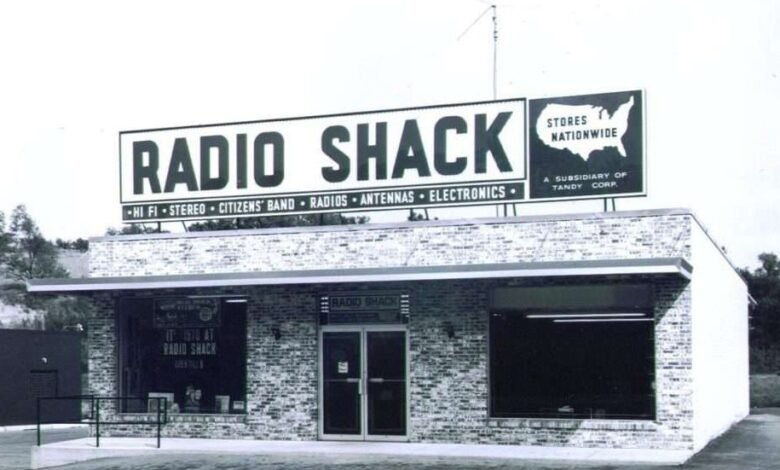The Rise & Fall of Radio Shack: A Short History


 Radio Shack once sold everything from ham radios to the earliest personal computers to components of powered space missions. It was a technology empire that fueled innovation and captured the imagination of countless inventors and hobbyists. But how did such a seemingly ubiquitous company with such a legacy fall apart?
Radio Shack once sold everything from ham radios to the earliest personal computers to components of powered space missions. It was a technology empire that fueled innovation and captured the imagination of countless inventors and hobbyists. But how did such a seemingly ubiquitous company with such a legacy fall apart?
In 1921 in Boston, Massachusetts two brothers Theodore and Milton Deutschmann’s passion for amateur radio led them to open a small retail and mail order store named Radio Shack. The name refers to a small wooden structure that housed a ship’s radio equipment.
Among the store’s first devoted customers were maritime radio officers and then amateur ham (short wave) radio operators, who could find parts and supplies for everything from from transceivers to antennas. Like today, these rapidly advancing technologies frequently saw new and updated products come to market.

 By the 1940s, Radio Shack had become a well-known and trusted local name, with the company issuing its first mail-order catalog in 1939. These showcased the latest innovations in radio technology, which surged during and after the Second World War.
By the 1940s, Radio Shack had become a well-known and trusted local name, with the company issuing its first mail-order catalog in 1939. These showcased the latest innovations in radio technology, which surged during and after the Second World War.
During the period the chain was based in Boston, it was commonly referred to disparagingly by its customers as “Nagasaki Hardware”, as much of the merchandise was sourced from Japan, then perceived as a source of low-quality goods.
In the post-war era the Deutschmann brothers saw an opportunity to expand beyond amateur radio and into the high fidelity (Hi-Fi) music market catering to a growing consumer base eager to hear superior sound from their radios and record players at home.
In 1954 the company started selling its private label products under the Realist brand, although a legal challenge required a change to Realistic.
Tandy Corporation
By the 1960s Radio Shack had expanded to nine stores and built a large mail order business, but began to suffer from various changes in consumer retail habits, along with the decline of downtown shopping and the rise of malls.
In the early 60s Tandy Corporation originally known under the name Tandy Leather primarily for leather goods, sought new ways to expand its business. Tandy Leather already had a significant presence in New York State.

 Under the leadership of Charles D. Tandy the company set its sights on Radio Shack which was already a struggling retail chain on the brink of bankruptcy. Tandy acquired Radio Shack in 1962 for just 300,000, transforming both companies into key players in the burgeoning consumer electronics market
Under the leadership of Charles D. Tandy the company set its sights on Radio Shack which was already a struggling retail chain on the brink of bankruptcy. Tandy acquired Radio Shack in 1962 for just 300,000, transforming both companies into key players in the burgeoning consumer electronics market
The did this by recognizing the untapped potential in retail electronics, especially among hobbyists looking for affordable products and components. The company’s focus shifted toward technology enthusiast and DIYers rather than the average electronics consumer and from large stores to more and smaller locations.
They also cut product offerings from some 40,000 items to about 2,500, eventually closing the by then unprofitable mail order division and eliminated and focusing on sales and marketing.
The heart of the business lay in Radio Shack local stores and the knowledge of its employees which helped create community hubs for electronics enthusiasts looking for affordable products they could
modify and enhance. Tandy famously said his company was not targeting those wanting to splurge on high-end sound systems but those eager to save money and invest their time improving their purchases.
This resonated with a generation of nerds and budding engineers, many of whom would go on to shape the technology of today. During the 1970s and 80s Radio Shack transformed from a niche electronics retailer into a household name across America.
For example, in 1977 Radio Shack introduced the TRS-80, one of the first mass-produced personal computers, a complete pre-assembled system at a time when most computers were built from kits.
By 1978 the company had grown to over 4,600 stores strategically positioned in shopping neighborhoods and malls where market research said their customers could be found. This growth was fueled by a unique business strategy that centered on two-way and citizens band (CB) radios wildly popular during that era.
In the 1980s Radio Shack stores were a treasure trove for electronics enthusiasts offering everything from small electronic components to batteries and accessories. One notable promotion was a “battery of the month club” which attracted customers with a promise of free batteries monthly.

 A pivotal change for Radio Shack came in 1982 with a breakup of the Bell System (Ma Bell) which ended that company’s longstanding monopoly over telephone services. This change encouraged consumers to purchase their own phones rather than renting them from the phone company.
A pivotal change for Radio Shack came in 1982 with a breakup of the Bell System (Ma Bell) which ended that company’s longstanding monopoly over telephone services. This change encouraged consumers to purchase their own phones rather than renting them from the phone company.
Radio Shack swiftly expanded its inventory to include a wide range of landline phones, becoming the go -to place to purchase a home phone or other telecommunication needs from pagers to video cameras to early home satellite TV and game systems.
By 1986 the company had expanded into international markets under and by 1990 Radio Shack boasted around 14,000 stores worldwide. As the 1990s dawned Radio Shack’s parent company, Tandy Corporation, became one of the largest computer manufacturers in the US.
Producing hardware, software, cables and electronic components they partnered with Panasonic and acquired Computer City in 1991. Throughout the decade they focused on affordable family computers and multimedia PCs.
Radio Shack reached a peak in 1999, when Tandy operated over 8,000 stores in the United States, Mexico, and Canada, and under the Tandy name in The Netherlands, Belgium, Germany, France, the United Kingdom, and Australia.
The Decline of Radio Shack
Radio Shack’s decline can be attributed to missed opportunities and strategic missteps. For one, they had an over-reliance on brick and mortar stores, while Amazon and Best Buy turned toward online retailing. Remarkably, Radio Shack only launched its first website in 1999.
The company also discontinued its in-house Realistic brand in favor of more widely recognized brands like RCA (Radio Corporation of America) which allowed for more selection, but higher prices.

 The company attempted to adapt in the early 2000s by pivoting toward cell phone sales and accessories and at one point cell phones accounted for about 50% of Radio Shack’s total sales in market dominated by decreasingly few brands, especially after the launch of the iPhone in 2007 and the transition of sales towards direct purchases through wireless carriers.
The company attempted to adapt in the early 2000s by pivoting toward cell phone sales and accessories and at one point cell phones accounted for about 50% of Radio Shack’s total sales in market dominated by decreasingly few brands, especially after the launch of the iPhone in 2007 and the transition of sales towards direct purchases through wireless carriers.
In the 2000s Radio Shack shifted from a company known for selling electronic gadgets and components for DYIers to a focus on selling cell phone plans for major carriers like Verizon AT&T, T-Mobile and Sprint.
This store-in-a-store model relied heavily on experienced sales people and store managers. An initiative to improve their performance evaluated the company’s 5,000 locations and targeted the bottom 1,500 under-performing store managers.
These were given 90 days to improve their stores’ performance, and at the end of the effort 1,700 managers were fired or demoted, creating widespread worker distrust and insecurity.
The aggressive strategy at first appeared successful and in 2005 Radio Shack reached a revenue peak of $5 billion, but the cracks began to show. Net profits declined dramatically, in large part from the decision to resell cell phones and accessories that by then were widely bought directly.
Since they had little control over their pricing, they couldn’t compete with the deals customers could find directly on the carrier’s website. Online shopping also surged dramatically making shopping for hobbyist electronic components at an old fashioned Radio Shack, well, old fashioned.
As the company’s fortunes declined after 2005 it became clear that their strategy had left them vulnerable and their profitability steadily dropped. There was also a regular turnover of management, with seven different CEOs heading the failing company between 2005 and 2014.

 By 2012 Radio Shack was posting negative earnings and to stay afloat the company secured a $585 million line of credit from GE Capital in 2013 alongside a $250 million loan from Salus Capital Partners. These came with strict conditions on how many stores they could close annually.
By 2012 Radio Shack was posting negative earnings and to stay afloat the company secured a $585 million line of credit from GE Capital in 2013 alongside a $250 million loan from Salus Capital Partners. These came with strict conditions on how many stores they could close annually.
The real estate of some failing companies are worth more than the companies themselves and when Radio Shack moved to close many of its stores, Salus blocked the move. Disastrous holiday seasons for the company in 2014 and 2015 were a final straw.
In February of 2015, after 11 consecutive quarterly losses, Radio Shack was de-listed from the New York Stock Exchange and subsequently filed for Chapter 11 bankruptcy.
In May 2015, the company’s assets were purchased by General Wireless, a subsidiary of Standard General, for $26.2 million, but two years later General Wireless and subsidiaries also filed for bankruptcy.
Radio Shack announced plans to shift its business primarily online and shut down most of its stores leaving only 1,700 remaining. These were co-branded with Sprint in an effort to keep the brand alive.
These developments turned Radio Shack into a mobile phone retailer with a limited selection of electronics. Stores once brimming with cables, components and gadgets for amateur technologists were reduced to a sparse collection of peripherals overshadowed by Sprint.
In 2017, just two years after the first bankruptcy, Radio Shack filed for bankruptcy again and the nearly all remaining stores were liquidated and closed.
There have been several attempts since to revive the company. It was acquired by Retail Ecommerce Venture and is operated primarily as an e-commerce website with a network of independently owned and franchised stores.
In May 2023, the El Salvador-based franchisee Unicomer Group acquired control of the worldwide Radio Shack business.
Illustrations, from above: The first Radio Shack store, Boston, MA, opened in 1921; an older Radio Shack store interior in 1971; a Radio Shack store, ca. 1963-1970; introducing the Radio Shack TRS-80 Micro Computer System (1977); a Radio Shack interior, 2002; and a closing Radio Shack in Chelsea, Manhattan in 2017.
Source link




